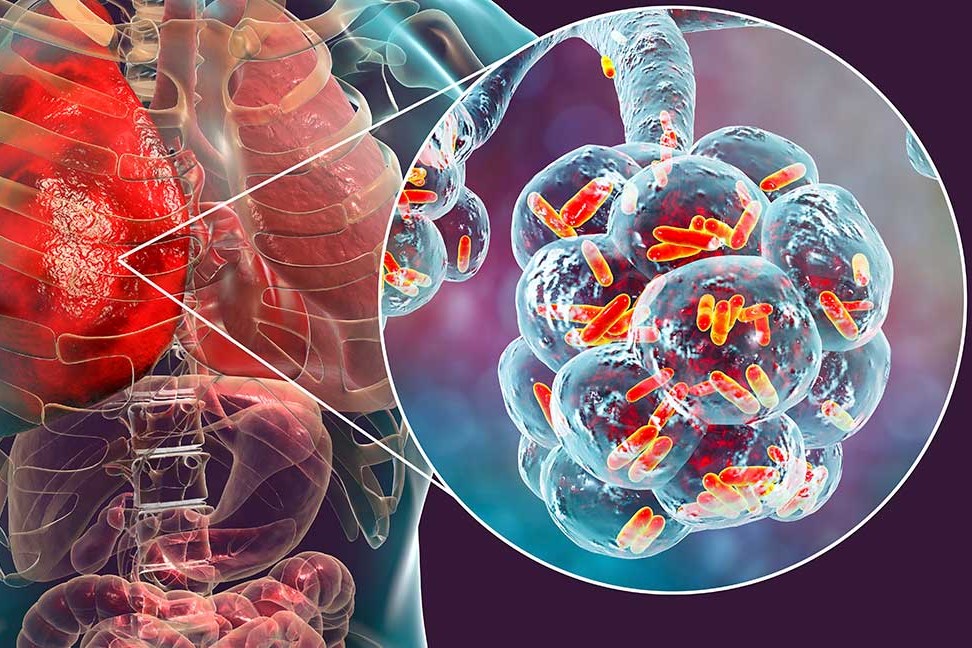
Legionella and Legionellosis: symptoms, diagnosis and treatment
What is Legionella? Legionella pneumophila is a genus of aerobic gram-negative bacteria responsible for infectious diseases of the respiratory system (Legionellosis)
The name derives from an epidemic that spread among the participants of the American Legion’s reunion at the Bellevue Stratford Hotel in Philadelphia, which in 1976 killed 34 of 221 people infected with a hitherto unknown form of pneumonia.
On that occasion, the source of bacterial contamination was identified in the hotel’s air conditioning system.
The Legionella bacterial agent, of which almost 50 different species and more than 70 strains have been identified, colonises humid and warm environments, both natural and man-made
Although it is present in nature in concentrations that do not pose a danger, Legionella lives in aquatic environments such as ponds, lakes and rivers and is able to proliferate within water-fed systems (reservoirs and tanks, air conditioning systems).
Signs and symptoms of Legionellosis infection
Depending on its symptoms and evolution, Legionella infection can manifest itself in different forms and give rise to two clinical pictures: Pontiac Fever and Legionnaires’ Disease.
Pontiac Fever is a flu-like form that has an incubation period of 24-48 hours. The symptoms, which are not very severe, are fever, general malaise, myalgia, headache and sometimes cough, and usually resolve in 2-5 days.
Legionnaires’ disease is the most severe form of the infection.
After an incubation period ranging from 2 to 10 days (on average 5-6 days), it manifests itself with pneumonia and high fever, colds, dry cough, asthenia, headache, loss of appetite and occasionally gastrointestinal complaints and kidney disorders.
Complications of legionellosis may include lung abscess, respiratory failure, empyema, thrombocytopenic purpura and kidney failure.
How Legionellosis is contracted
Legionellosis, the form of pneumonia caused by Legionella, is a non-contagious infectious disease.
It is not transmitted from person to person but by aerosol inhalation, i.e. inhaling airborne water droplets containing Legionella bacteria.
The main aerosol-generating systems that can facilitate the spread of disease transmission include water systems, air conditioning systems (heating, ventilation and air conditioning systems and their components), assisted breathing therapy equipment and whirlpools.
It follows that the facilities potentially most exposed to risk are social-health facilities, residential social-assistance facilities, and tourist accommodation facilities (hotels, swimming pools, gyms, workplaces and collective meeting places).
Who is at risk of Legionellosis
Legionella infection prevails and is more serious in the following cases
- infants
- elderly people
- immunocompromised patients with chronic diseases such as diabetes and chronic obstructive pulmonary disease (COPD)
- Cigarette smokers
- immunocompromised patients (typically with reduced cell-mediated immunity).
The lungs are the site most affected by the infection; nosocomial and extrahospital pneumonias may occur.
Extrapulmonary legionellosis is rare; manifestations include sinusitis, hip wound infection, myocarditis, pericarditis and prosthetic valve endocarditis, often in the absence of pneumonia.
How the diagnosis is made
A chest X-ray should always be performed: this usually shows irregular and rapidly progressive asymmetrical infiltrates (even when effective antibiotic therapy is used), with or without small pleural effusions.
When legionella infection is suspected, the simplest test is a urine test:
- rapid urinary agent test: it is only useful for serum group 1, has a sensitivity of 60-95% and a specificity of 99% when performed three days after the onset of symptoms. It is specific for Legionella Pneumophila and not for other legionellae.
- In doubtful cases, a serum anti-Legionella antibody test can be used: a 4-fold increase or an acute titre > 1:128 is considered diagnostic.
- In Legionnaires’ disease, bronchoalveolar lavage sputum culture is useful.
- Blood cultures are not reliable. Direct fluorescence stains on sputum or wash fluid are occasionally used, but require experience. In addition, polymerase chain reaction tests with DNA probes are available and can help identify transmission routes, which are useful for the epidemiological study of the disease.
- Laboratory abnormalities often include hyposodukaemia, hypophosphatemia and elevated aminotransferase levels.
Therapy: how to treat Legionellosis
Legionella does not respond to all antibiotics, so when considering this infection the drugs of choice include fluoroquinolones and macrolides.
Fluoroquinolones should be used for 7-14 days, among the macrolides azithromycin may be preferred for 5-10 days. Erythromycin is not recommended.
Potentially useful drugs are also doxycycline (in the uncomplicated forms of the immunocompetent patient) and rifampicin, on which not everyone agrees.
How to prevent Legionella infection
Strategies to combat the proliferation of Legionnaire’s Disease stem first of all from prevention with procedures that help reduce the possibility of bacterial pollution to be implemented during the design, installation, operation and periodic maintenance of plant systems (disinfection treatments, chemical treatments).
Read Also:
Emergency Live Even More…Live: Download The New Free App Of Your Newspaper For IOS And Android
Pneumocystis Carinii Pneumonia: Clinical Picture And Diagnosis
Kaposi’s Sarcoma: Discover What It Is
Pneumonia: Causes, Treatment And Prevention
Pneumothorax And Pneumomediastinum: Rescuing The Patient With Pulmonary Barotrauma
Bronchitis And Pneumonia: How Can They Be Distinguished?
Tracheal Intubation: When, How And Why To Create An Artificial Airway For The Patient
What Is Transient Tachypnoea Of The Newborn, Or Neonatal Wet Lung Syndrome?
Pneumothorax And Pneumomediastinum: Rescuing The Patient With Pulmonary Barotrauma
Pneumonia: Causes, Treatment And Prevention


